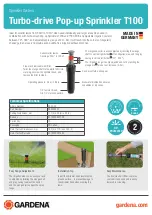
•
Do not mount the controller on surfaces prone to
vibration, such as duct work.
•
Do not mount the controller in areas where
electromagnetic emissions from other devices or
wiring can interfere with controller communication.
Observe these additional guidelines when mounting a
controller in a panel or enclosure:
•
Mount the controller so that the enclosure walls do
not obstruct cover removal or ventilation through the
controller.
•
Mount the controller so that the power transformer
and other devices do not radiate excessive heat to
the controller.
•
Do not install the controller in an airtight enclosure.
Figure 1: Controller Mounting Positions
DIN Rail Mount Applications
Mounting the controller horizontal on 35 mm DIN rail is
the preferred mounting method.
To mount a controller on 35 mm DIN rail:
1. Securely mount a 20 cm (8 in.) or longer section of
35 mm DIN rail horizontal and centered in the desired
space so that the controller mounts in the horizontal
position shown in
Figure 1
.
2. Pull the two bottom mounting clips outward from the
controller to the extended position (
Figure 2
).
3. Hang the controller on the DIN rail by the hooks at
the top of the (DIN rail) channel on the back of the
controller (
Figure 2
), and position the controller snugly
against the DIN rail.
4. Push the bottom mounting clips inward (up) to secure
the controller on the DIN rail.
To remove the controller from the DIN rail, pull the
bottom mounting clips out to the extended position
and carefully lift the controller off the DIN rail.
Wall Mount Applications
To mount a controller directly on a wall or other flat
vertical surface:
1. Pull the two bottom mounting clips outward and
ensure they are locked in the extended position as
shown in
Figure 2
.
2. Mark the mounting hole locations on the wall using
the dimensions in
Figure 2
and one of the mount
positions shown in
Figure 1
. Or hold the controller up
to the wall or surface in a proper mount position and
mark the hole locations through the mounting clips.
3. Drill holes in the wall or surface at the marked
locations, and insert appropriate wall anchors in the
holes (if necessary).
4. Hold the controller in place, and insert the screws
through the mounting clips and into the holes (or
anchors). Carefully tighten all of the screws.
Important:
Do not overtighten the mounting screws.
Overtightening the screws may damage
the mounting clips.
Figure 2: Back of Controller Showing Extended
Mounting Clips, DIN Rail Channel, and Mounting
Dimensions, mm (in.)
2
FX-PCX37 Expansion Input/Output Module Installation Instructions



































